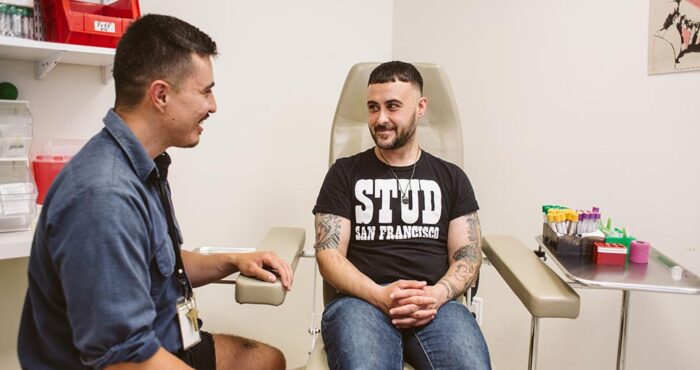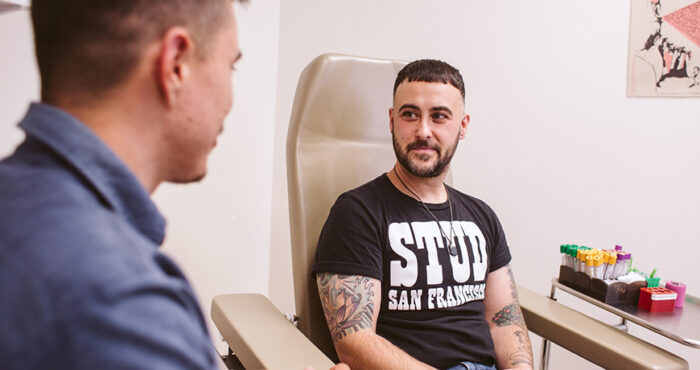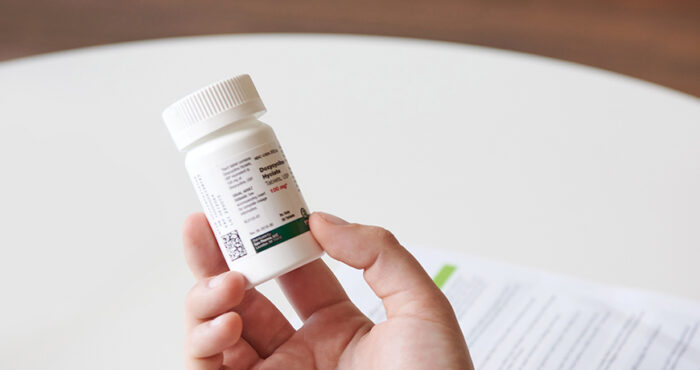Raw sex: What the research says about risk when you’re undetectable
Editor’s note: This article is about the research on treatment as prevention (TasP), an effective method of HIV prevention. It does not promote condomless sex or provide commentary on when people should or shouldn’t use condoms. When used consistently and correctly, condoms provide protection from HIV in addition to protection from many sexually transmitted infections. Learn more about how well condoms work to prevent HIV.
John and his husband stopped using condoms several years ago—even though John is living with HIV and his husband is HIV-negative. John’s husband isn’t on PrEP or PEP. How does John’s husband stay HIV negative, and why don’t either of them have to worry about HIV transmission?
John and his partner rely on a method of HIV prevention called treatment as prevention (TasP).
It may sound complicated, but in reality, it’s very simple. And, it works. By taking his HIV medications regularly, and maintaining an “undetectable” viral load, John is able to keep himself healthy and protect the health of his husband. That’s because HIV-positive people with undetectable viral loads do not transmit HIV to anyone else.
“We stopped using condoms sometime after 2008,” said John. “I did worry, a bit at first, [about HIV transmission], but we don’t worry anymore. I have been living with HIV since before 1988, and probably got to undetectable by 1997. I’ve been undetectable since then.”
John and his husband have very little reason to worry about HIV transmission. For a long time, health providers and researchers suspected that people living with HIV, on treatment, who maintained undetectable viral loads were unlikely to transmit HIV to anyone else. But only recently have very large clinical trials demonstrated that people on treatment, who maintain undetectable viral loads, do not transmit HIV to sex partners.
Here’s what we know about how effective treatment as prevention is—and why we know it works.
TasP works for heterosexual couples
A study published in 2011 in the New England Journal of Medicine was the first large-scale study to offer definitive proof that treatment as prevention works—at least for heterosexual couples. (Final results from the study were published in 2016.)
The study, called HPTN 052, was designed to answer two questions: First, is it better for people living with HIV to start antiretroviral therapy right away for health reasons? And second, can antiretroviral therapy that suppresses HIV replication prevent the sexual transmission of HIV? The answer to both of those questions, the study found, is resoundingly YES.
The study included 1,763 serodifferent (different HIV status) couples in Africa, Asia and the United States, with an average follow-up time of over 5 years. Said another way, this was a long study, with a lot of people.
About half of the people living with HIV in the study were asked to begin antiretroviral therapy immediately, while the other half were asked to delay HIV treatment until two CD4 counts in a row were below 250 cells/mm3. (This study was started in 2005, before physicians knew that it was better to begin HIV treatment as soon as possible.)
The researchers then looked at the difference in the number of new HIV infections that happened in couples who were on HIV therapy, versus those who were not. Before the study was completed, in May 2011, the researchers found that people in the study on ART had a 96% reduction in risk of transmitting HIV to their partner than people who were not yet on ART. Because of this, the data safety and monitoring board for the study changed the study protocol—so that everyone living with HIV in the study was offered ART.
Over the course of the entire study, taking ART was associated with a 93% lower risk of HIV transmission. A total of 43 HIV infections happened in couples when the HIV-positive person delayed their HIV treatment. Only 3 HIV infections happened in couples when the HIV-positive person started ART right away. (This includes only HIV infections that were genetically linked—in other words, ones where it was verified that the HIV infection came from the partner in the study.) It is believed that none of the people who transmitted HIV to a partner were virologically suppressed at the time when the transmission occurred.
“If people are taking their pills reliably and they’re taking them for some period of time, the probability of transmission in this study is actually zero,” said Myron Cohen, MD, principal investigator of the HPTN 052 study, in an interview with Plus.
HPTN 052 had a big, immediate impact when results of the study first came out, with experts heralding the findings as “groundbreaking” and “landmark” for HIV prevention and treatment. Policies and treatment guidelines, all over the world, started changing after HPTN 052 results became available. Evidence that early treatment not only improves the health of people living with HIV—regardless of how high or low their CD4 counts are—but also prevents HIV transmission, caused health agencies to recommend HIV treatment for everyone living with HIV.
“This breakthrough is a serious game changer and will drive the prevention revolution forward. It makes HIV treatment a new priority prevention option,” said Michel Sidibé, Executive Director of the Joint United Nations Programme on HIV/AIDS (UNAIDS) in 2011. “Now we need to make sure that couples have the option to choose Treatment for Prevention and have access to it.”
TasP works for men who have sex with men
After the results from HPTN 052 came out, experts theorized that findings from HPTN 052 might also apply to people besides heterosexual people having vaginal sex. But many people not having vaginal sex, including men who have sex with men having anal sex, wondered if treatment as prevention would work for them, too.
“At the individual level, there is no reason to think that successful treatment won’t also reduce the risk of HIV transmission for gay and bi men (and others who engage in anal sex). However, it is still not clear if this reduction will be as great as it was for heterosexual couples in the HPTN 052 study (who were mostly engaging in vaginal sex). Even if the reduction in risk is the same for gay and bi men, the risk of HIV transmission while on treatment may still be higher for anal sex than for vaginal sex,” wrote James Wilton from CATIE in 2013.
John remembers one doctor telling him that there was little risk of him being infectious because his viral load was undetectable in the early 2000s. Still, he felt there wasn’t enough evidence to back that claim up. John assumed that the risk of transmitting HIV to his partner was low because of he was undetectable, and because his partner was the “top.” Even still, he remembers not feeling completely reassured that he was unlikely to infect his partner until the results of a study called PARTNER were released, in 2014.
Early results from the PARTNER study started to provide definitive answers for men who have sex with men. Showing, definitively, that gay men who maintain an undetectable viral load do not transmit HIV to sex partners.
The PARTNER study included both men who have sex with men and heterosexual people in serodifferent relationships who weren’t using condoms, taking PrEP, or on PEP. The people living with HIV had suppressed viral loads (under 200 copies/mL). The study was large—with 888 couples providing data—and spanned 75 clinical sites in 14 European countries.
Out of the 340 couples of men who have sex with men, the researchers had data from 1,238 couple-years of follow-up combined. Men in the study reported a median of 42 condomless sex acts per year, with more than 22,000 condomless sex acts reported during the study.
The researchers followed this group of serodifferent couples over time to track the HIV infections that occurred, and ask the men about the type of sex that they were having.
Over the almost four years of the study, ten men acquired HIV. Interestingly enough, none of them acquired HIV from their HIV-positive, undetectable primary partner.
In other words, the HIV infections happened during sex with someone who was HIV-positive but not on treatment or otherwise not virally suppressed. The researchers were able to verify this by comparing the genetic strains of HIV of people who tested positive during the study, with the strain of HIV their partner had (and in all 10 cases, the strains did not match).
Given that there were no linked HIV transmissions, the researchers estimated that the risk for HIV transmission with an HIV-positive partner taking ART with a viral load of less than 200 copies/mL was zero. This held true for men who have sex with men during insertive sex, receptive sex, receptive sex without ejaculation, and receptive sex with ejaculation.
“Based on the number and type of sex acts and the cumulative probability of HIV transmission, more than 100 transmissions would have been expected if the HIV-positive partner had not been taking ART,” the researchers said, demonstrating just how effectively HIV therapy can be in preventing new transmissions.
The researchers did qualify their results, saying that they “cannot directly provide an answer to the question of whether it is safe for serodifferent couples to practice condomless sex,” and that more data will be needed to determine what the error of margin is on the zero estimate. (For receptive anal sex with ejaculation, there was a higher margin of error due to the lower number of these reported sex acts overall).
The bottom line
We now have conclusive evidence that maintaining an undetectable viral load prevents transmission of HIV to sex partners. For many people, this new biomedical method of HIV prevention offers a renewed sense of freedom, brings less anxiety around sex, and reduces stigma associated with HIV.
“I think people these days take a lot of confidence in the fact that it is possible to have a serodiscordant relationship, and to make it work,” said John. “These days, if someone else want to use a condom, I’d respect their preference. But I don’t feel like it’s something I’m obligated to do now. I don’t feel like I’m putting anyone at risk by having sex with them.”
Learn more about the PARTNER study, blips and low-level viremia and what it means to be undetectable.










